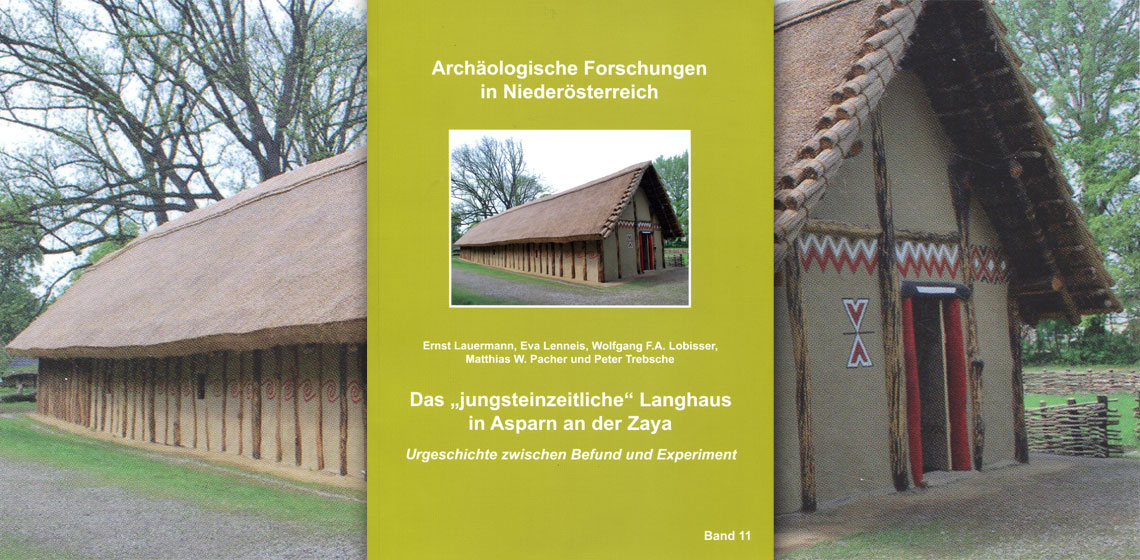
In 1970, the Archaeological State Museum of Lower Austria, founded by F. Hampl in the town of Asparn an der Zaya, Austria, some 60 km north from Vienna, was officially declared open. The finds excavated from the region were put on display in the castle of Asparn, whilst the living conditions of prehistoric people were illustrated within an open-air area established in the castle grounds. Reconstructions of tents, huts, and houses from all periods of prehistory were erected to impart an idea to the visitors on how people lived and constructed their dwellings in former times.
The reconstruction of a longhouse from the Linear Pottery Culture period, had already started back in 1964, following an original find from Köln-Lindenthal (Germany). For many decades this longhouse was one of the main attractions of the Asparn museum, and countless visitors were impressed by its architectonical features.
Unfortunately, in 2011 the primary structures of the longhouse were found to be decayed, especially the mainstays which were rotten through in the transition band between soil and air. Therefore, the access to visitors was blocked off due to the risk of collapse. The museum staff decided to deconstruct the building in a very careful and methodological manner, in order to thoroughly document its state, after surviving for more than 45 years. As of 2012 a new model of scale 1:1 was erected adjacent to the location of the old longhouse.
The present book, which is compiled by several authors, describes the open-air museum, the deconstruction of the decayed longhouse, the new replication along with its interior furnishing.
In the first part E. Lauermann, the current director of the museum, gives a brief overview of the history of the State Museum, pointing out that the whole area was intensively used for archaeological experimentation from 1970 to the present day. The former director, H. Windl , encouraged numerous archaeology students to carry out experiments and also focused on imparting knowledge about prehistoric techniques through demonstrations by archaeo-technicians representing different crafts, such as metal casting and processing, weaving and dying, and much more. These various activities are impressively depicted through hundreds of photos, both old and new.
Part two, co-authored by E. Lenneis and P. Trebsche, deals with the story of the old longhouse built in 1964: what were the basic facts underlying the (re)construction; how was the superstructure done; is there any evidence for repairs?
It was a special challenge for the archaeologists to document the actual state of a building which is still standing, instead of recording the traces left in the ground by a house which was destroyed thousands of years ago. They found out that after 47 years the upper ends of all posts were still intact, whilst the lower parts, especially the sections buried in the ground were completely rotten and friable in almost every case. Again, the deconstruction work and the state of all structural elements are documented by numerous images illustrating every detail. This is highly interesting and valuable for future archaeological research, as it allows prudent conclusions regarding the durability of wooden elements along with the life span of original buildings e.g. from the Stone Age, even though this house was never utilised the way houses would have been employed thousands of years ago.
Hereafter, W. Lobisser reports the planning and erection of the new longhouse model performed by the Vienna Institute for Archaeological Science (VIAS), who specialize in reconstructing prehistoric architecture. The basic considerations for the construction are comprehensively explained, albeit Lobisser´s focus on the existence of a prehistoric “foot” measurement, which is not clearly explained and is reminiscent of the discussion regarding the “megalithic yard”.
In the fourth section E. Lenneis puts forth her thoughts concerning the (re)construction details along with the interior details of a prehistoric LBK house. In this case, the find from Schwechat/Austria, whose plan was used as the base for Lobisser´s (re)construction, was used for the model (scale of 1:1) in Asparn and is furnished the way it could have probably been 7000 years ago.
Finally, M. Pacher depicts the open-air museum´s potential and opportunities for communicating and imparting the knowledge and results of archaeological research with regards to tourism, experimentation and public relations.
All in all, a very interesting book not only for archaeologists involved in excavating prehistoric dwellings but also for archaeo-technicians (re)constructing prehistoric buildings and researchers dealing with the history of didactic work in open air museums.
Book information:
Lauermann, E. (et al.) 2013. Das "jungsteinzeitliche" Langhaus in Asparn an der Zaya. Urgeschichte zwischen Befund und Experiment.Archäologische Forschungen in Niederösterreich 11. St.Pölten: Selbstverlag des NÖ Instituts für Landeskunde. Paperback, 196 pages B/W and coloured. ISBN 978-3-901635-54-0 Euro 25,-